This
post was originally published on
this siteOriginally posted at: http://www.nerdfitness.com/
Last month, I saw Larry’s success story posted in the Nerd Fitness Academy private Facebook group. He’s a proud member of the Academy. (Remember on Monday when we told you about all the new workouts, fitness quests, and epic boss battles features?) Click here for a video walkthrough of each section of the Academy.
Larry’s story put a MASSIVE smile on my face and I knew I had to share his story here with the whole Rebellion.
A year and a half ago, he woke up with such intense pain that he could barely get out of bed.
“The pain came on overnight and it was explosive and everywhere, I thought to myself that this was something that was probably serious and I should find out what is going on.”
6 months of doctors and insurance questions later, and Larry learned he had Rheumatoid Arthritis.
“Drugs ensued and changes happened to my body because of the disease and the medications that I was being prescribed. With the drugs the disease became manageable and I could start living in a world that was not consisting solely of pain and the feeling that I was made of glass and would break with the merest touch.”
This was Larry’s starting point, a point many can relate to: a health problem being the source of a rude awakening. Other than remodeling his house, Larry was living a practically sedentary and unhealthy lifestyle.
But – spoiler alert – things changed. Larry retook control; he lost an enormous amount of body fat and regained that weight as muscle. His body transformed over the course of the year, and eventually he defeated the very disease that served as his signal flare that something needed to change.
Here’s how he did it:
The First Three Months
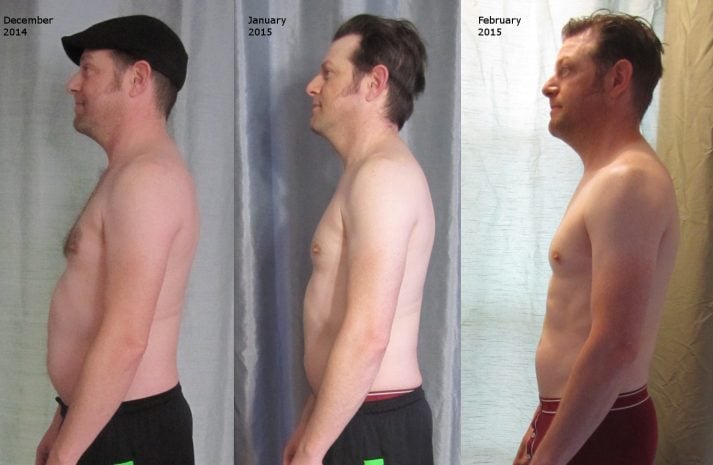
Where did Larry start? Where would you start if you were approaching a problem you didn’t know much about? Reading!
In the course of trying to get my health together I did what I am sure everybody does, read tons of stuff that doesn’t really touch you or inspire you. Find a lot of crap science, (I am uneducated about fitness but not stupid). See a lot of people that want your money for questionable returns.
Then I came across Nerd Fitness. It informed in a simple and intelligible way that was also made fun, it was apparently what was needed because it put a lot of things into perspective and allowed me to make a path that was genuinely exciting and had me looking forward being a part of something.
But Larry didn’t just read and read (we call it, collecting underpants). He also just started right away, knowing it was going to be a bit… uncomfortable:
Off to the gym we go and embarrassment ensues. So I saw myself as being a strong guy because I did what I thought were strong things like remodeling my house. I was wrong. It turns out that I am not very strong and I had very little stamina.
When I hit the gym my stats were as such. I was just turned 41 years old 5’9″ and I weighed 185 lbs and was considered obese, I smoked and drank alcohol daily and was pretty sedentary as well because I was pretty afraid of pain.
I also learned that I could only do the following, bench press 55 lbs, squat 65 lbs , deadlift 95 lbs, standing row 55 lbs and overhead press 45 lbs. As well as I could only ride on an exercise bike for about 5 minutes at speed before feeling like I was passing out and had to stop.
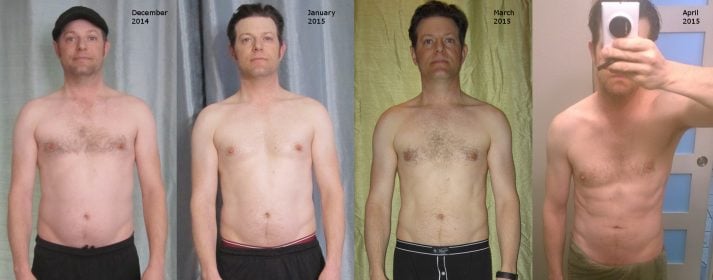
That’s when Larry stepped up his game. His first reality check was his diagnosis. His second reality check was his first day in the gym. He needed some more help. So he made a mental shift: he was going to make a long term commitment.
He was going to make this investment in himself, despite feeling a bit foolish at being a newbie:
The following day I felt like I had been beaten and kicked to death and my pride was severely wounded. Unfortunately I had no choice but to continue. I decided that this is a long-term 10 year plan into health and fitness.
This is the point that Nerd Fitness started playing a more active role, after I read all of the articles that were available I decided to join The Nerd Fitness Academy. I now had accountability to something other than my wife (also in The Rebellion). With this new tool I could build a plan that was fun but also gave a basic set of information that allowed me to start as well as getting support and inspiration from people in similar circumstances.
This gave me the motivation that I needed to get started and to keep going.
Over the next 3 months I watched what I ate but only moderately and went to the gym regularly, trying to learn more about what I should be doing. There was a lot of pain, in my muscles and my joints but again there is no other option but to continue.
It was during this time that I lost a good chunk of the excess fat while very slowly I was getting stronger. At this point I decided that it was time to stop the smoking and stop drinking and to be more mindful of my consumption of food in relation to my workouts, all of which was harder than I thought. I also started trying to be less sedentary and to spend more time outdoors again.
3 Months later
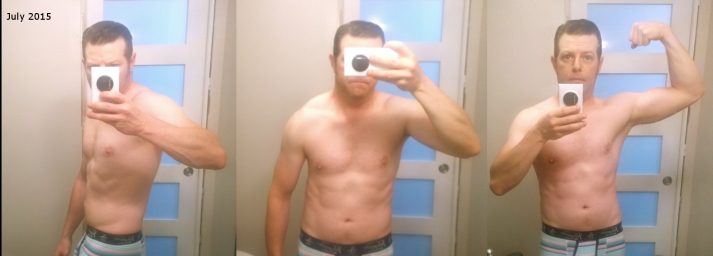
Three months later, Larry was still going strong, but still had some serious changes to make:
Over the next 3-4 months I continued to go to the gym and leveling up in the Nerd Fitness Academy.
In the beginning I really had no idea what I was doing and just wandered around the gym sorta screwing around with different machines to see what hurt me the least, I figured that at least I was doing something.
After about a month of this I decided that it was time to move to the free weights, I had spent the previous month reading everything at NF as well as starting to do additional research outside of it as well and I would compare information.
I spent the next 6 months working on my fundamental strength with the 5 big lifts (squats, deadlifts, overhead presses, bench presses, barbell rows). I moved from 6 days a week to just 3 days a week.
When the summer came I made another tweak to my program: I was in the gym 4 days a week and during the off days was doing calisthenics. This also lasted for about a month. It was at this point that I realized that I was doing the same thing as I did in the beginning and was really just screwing around and not being focused.
So I went back to just doing the big lifts 3 days a week after work with the odd accessory work or mild cardio thrown in just for a little variety. My off days are for doing fun things that get my body moving and trying to be outside as much as possible. I decide that at this point I want to be strong so I start focusing on that in my workouts and get rid of all the extraneous things that I had been doing, otherwise known as suffering from *%ckarounditis (Sorry for the censor, Larry, the Obligators made us!).
I bet we can all relate to Larry’s early gym experience. When we don’t really know what we’re doing, we bounce from exercise to exercise, machine to machine, with no real strategy When we aren’t focusing on the big wins – the stuff that plays a huge role in our success or failure – it’s easy to get distracted by the fun but less effective stuff.
That’s the basis behind the 80/20 rule and focusing on big wins: by just getting a few big things right (like getting very strong at certain lifts), you can set yourself up for success with relatively simple plan (the type of plans we have in the Nerd Fitness Academy).
After six months, Larry then successfully made some healthy changes to his diet and had an honest conversation with himself about how what he was putting in his body.
I was mostly an unhealthy pescetarian for 23 years. Many years of Taco Bell later, I finally made a change….. I started to eat what is considered a normal amount of food for a guy my size.
This in conjunction with getting most of the food from the fruit and veg section of the market for a change (plus lifting), meant that I dropped the weight gained from the medication I was on.
Months 6-12
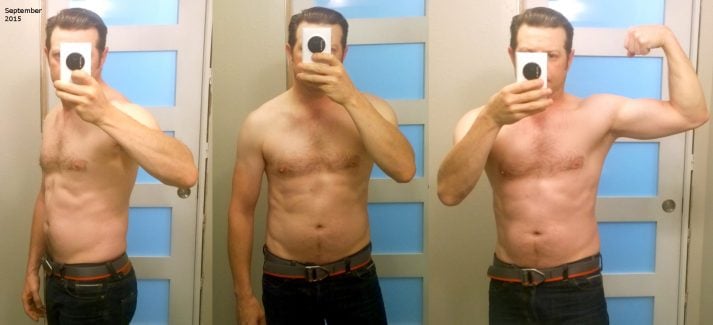
Larry found himself getting stronger and stronger, and his body was changing. This motivated him to start to dial in his diet even more. In his words, he knew his diet was the key to “feed the growing muscles.”
After the first couple of months I paid more attention to the type and quality of food that I was eating, boosted protein, as well as multivitamins to make up for my pescetarian diet. I also decided to begin Intermittent Fasting as I was never really a morning eater. Around this time I started carb loading, but didn’t like how the diet made me feel and noticed increased inflammation, so I tried a ketogenic diet.
I increased my total calories to 2800 to be above my maintenance of 2500. I am at the gym 4 days a week and working out for about an hour and 10 minutes.I am trying to be more mindful of my time and to take a little more time for myself and to be appreciative of all that I have. During this time I have been riding the bike and began kayaking as well. I have gone camping with friends and loved ones as well as some rock climbing thrown in so that I have more outdoors.
Thanks to his increased focus on a healthy relationship with food, and his weight fluctuated naturally between 165 lbs. and 170 lbs. Some months he decided he wanted to trim up, and he cut his calories down to 1600, while other months he increased his calorie intake to 4,000 on workout days, and 2,800 on off days.
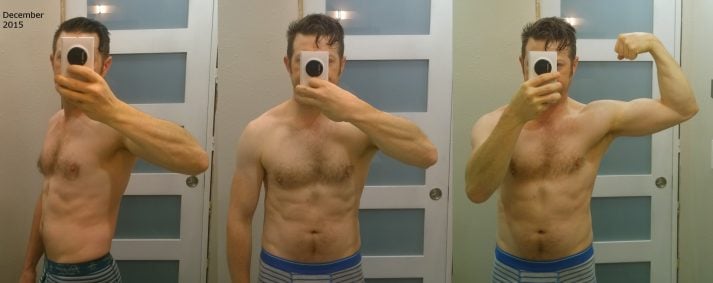
In short, Larry put a plan in place, listened to his body, and started eating in a way that lined up his goals. He realized that nutrition was a major piece of the puzzle, and if he was going to spend all that time in the gym, eating right made sure that wasn’t not time wasted.
Larry Today
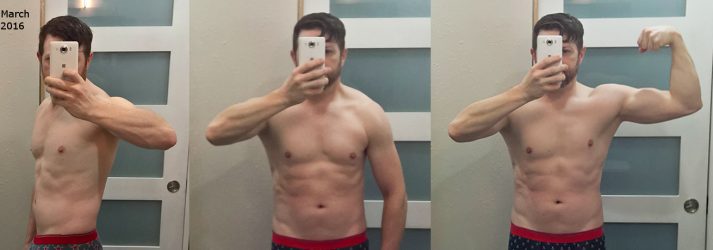
The cool thing about this story? Larry only has “before” and “during” photos, because his journey is never-ending.
There’s no “after” when he gets to go back eating like crap and not exercising…this is just the new Larry. This new Larry makes healthy decisions and gets strong as hell. He’s on a 10-year plan so he doesn’t freak out from day or day or week to week if he doesn’t see DRASTIC changes. He knows it’s going to take a long time, and he’s okay with that – every day is just like the day before: get stronger and eat according to plan.
While he used to struggle lifting anything heavier heavier than 50-75lbs, today he is squatting and deadlifting 295, and benching 175 for reps! He’s also tackling the exercise bike for a full 60 minutes.
And maybe the best news? That medical diagnosis of Rheumatoid Arthritis? Well…
I am happy with where this adventure has taken me and I look forward to the next 9 years of my 10 year plan. On the overall health front, I was told that all of my lab’s for the last 6 months have been normal which means that the disease is in remission.
The doctor also told me to lay off the remaining medication and if everything is good at our next appointment, then he would recommend staying off the meds unless I have a flare.
So apparently due to all the changes that I have made in the past 2 years I am now at the point where I am just a very healthy guy. I am very happy with how this is turning out. Good job, me! I owe a great deal of thanks to those of you at Nerd Fitness as you helped start me on this path. I know that I have a long slow path still ahead of me but I plan to keep my head down and keep on moving forward.
When we asked Larry about what else has changed in his life, he realized that while the physique and medical issue going away is great, it wasn’t the biggest thing:
The most fundamental change has been in the mind and my perception of myself and others and the desire to have everyone find the same thing that I have found in this path that I have chosen.
Not to mention that other people see me differently than before because I have more presence physically than I did before.
Larry’s outlook is simply different: he didn’t go into this expecting a quick change. He knows he’s there for the long haul. That’s why he told himself upfront that he was working to change over TEN YEARS! Not 30 days. Not two weeks before the beach. But a real, lasting change.
Why Larry Was Successful
Larry lost weight, gained muscle, and dramatically changed his physique. By his own account his most dramatic change wasn’t even physical – it was his mindset and how he relates to others.
That’s the type of comic book level change we all hope for, but so few achieve. How did he do it?
Larry got started right away, and made changes as he went. He made major changes to his diet months and months in. He didn’t use an excuse of needing learn more in order to delay and delay. He started with the knowledge he had, did the best he could, and learned as he went. He wasn’t afraid to look stupid and learned along the way. (That’s how we all do it!)
Larry had a program, and he followed it. There’s no need to reinvent the wheel when it comes to your workout and your nutrition. Your body is an incredibly complex thing, and beginners who try to plan their own workouts often leave huge gaps in programming. Following a basic beginner plan in order to learn the ropes, and guarantee success (if you actually do it). Stop piecing together workouts from magazines and blog posts. Pick a strategy and follow it!
Larry experimented and tweaked based on what he liked. Not only did Larry tinker with his workouts as he became more knowledgeable, he tried a wide variety of diet strategies too. When he tried carb loading and he didn’t like it, he switched. He moved into a more ketogenic diet, and he tweaked his calorie intake several times throughout his journey. This isn’t just about experimenting and finding what works for you. It’s about becoming the source of your own authority, about taking ownership over your success and being the one to make changes if need be. That’s an epic change.
Larry emphasized regular strength training. If you are trying to build muscle and lose fat, strength training combined with better food decisions is the best path in our opinion. If you aren’t currently strength training, it might be time for you to give it a try. You can even start with bodyweight exercises like push-ups and squats in your living room.
Larry took photos and tracked his progress. How else do you know if you’re succeeding if you don’t have something to compare yourself against? Take a photo (one profile view and one looking straight into camera) today, and another every month after now. As an overachiever who loved data, he also used a food tracker to keep himself in line on the calories and macros. He weighed himself each week and documented that in a spreadsheet, along with all other measurements. Larry became a videogame character, watching his experience bar rise and could celebrate small victories and improvements. The more data you can track for yourself, the easier it will be to tell if you’re on the right path or if you need to course-correct.
Larry answered the call. When Larry had a health issue – a giant red flag appear in his life screaming “something isn’t right; something needs to change!” – he did something. He got started. He didn’t let this new health issue demoralize him or turn into an excuse to go grab a pint of ice cream and commiserate. Instead, he seized the call to arms and dedicated himself to making a real change.
Your call to action doesn’t have to be a new chronic health issue. In fact, it shouldn’t be.
Let THIS article be your call to action on your hero’s journey.
I loved sharing Larry’s story with you today for this reason – I love that members of our community can help inspire each other – the Rebellion pulling itself up by its bootstraps. I love people that take imperfect action: course correct along the way, and keep hustling.
No quick fixes, just a lifelong journey. Will you heed the call?
-Steve
PS: I’m proud that Larry is a member of the Nerd Fitness Academy and used its philosophy and community to help him transform his life in many ways.
Later this week we’re increasing the price of the Academy, so if you’re on the fence now might be a great time to join! It comes with a 60-day money back guarantee in case you want to give it a shot!




 Do you look Primal?
Do you look Primal?









 For now classes are 6pm and 640pm at 2840 Wildwood st in the Boise Cloggers studio.
Book your class NOW!
click this ==>
For now classes are 6pm and 640pm at 2840 Wildwood st in the Boise Cloggers studio.
Book your class NOW!
click this ==>








